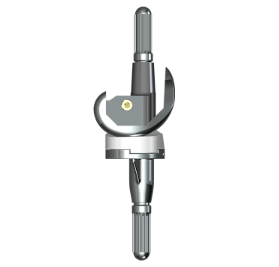Talk About The Full Contact And Stump Bearing Of The Prosthetic Receiving Cavity
 Jun. 05, 2019
Jun. 05, 2019
Here is Joint Prosthesis Manufacturer talking about Talk About The Full Contact And Stump Bearing Of The Prosthetic Receiving Cavity
If you have any idea about Knee Preservation Surgery Prosthesis, welcome to contact us and discuss.
When amputees are walking on lower limb prostheses, people tend to pay attention to the harmony of gait. Only when the residual limbs are bloated, discolored, bearing weight and blood circulation problems, people care about what happened to the residual limbs. The changes in the residual limbs are inseparable from the absorption of the inclusive limbs.
The receiving cavity is the most important part of the prosthesis. It directly contacts the residual limb, supports the weight of the human body, and controls the movement of the prosthesis. Whether the prosthesis is comfortable or not depends entirely on whether the receiving cavity is suitable. The receiving cavity is an important structure that affects the comfort and function of the prosthesis. Full contact and maximum stump load are the requirements of modern prosthetic assemblies for the receiving cavity. Unfortunately, it is often overlooked.

Load-bearing and exercise are the most fundamental effects of lower limb prostheses. A reliable "connection" between the residual limb and the receiving cavity ensures the realization of the prosthetic function. Any tiny "pseudo-joint" activity and "piston movement" between them can prevent the amputee's precise control of the prosthesis, thereby reducing the stability of standing and walking and increasing the patient's energy expenditure. The full contact between the residual limb and the receiving lumen contributes to the goal of a firm connection between the residual limb and the receiving lumen. Full contact requires that the residual limb be at least in contact and withstand a certain amount of pressure. Otherwise, you should consider improving the quality of the residual limbs by conservative or surgical methods before installing the prosthesis.
Wearing the ideal maximal stump-bearing prosthesis, the amputee should be able to stand on the bottom of the receiving cavity with the stump, just like standing on the ground before the amputation. Maximizing the use of stump weight is an important condition for prosthetics to become physiological. Stump load bearing not only has important biomechanical significance but also through the stump contact and bearing, the amputee's sensory nervous system can directly feel the important information from the bottom of the pressure and movement.
The stump load-bearing achieves the residual weight of the residual limb. It has a physiological role in preventing decalcification (passive osteoporosis). For children with amputees, it can also stimulate the growth of residual limbs.
The load-bearing capacity of the stump depends on the height of the amputation and the quality of the soft tissue, depending on the surgical technique. Among the calf amputees, the ability of the long residual stump to bear the load is less than 20% of the body weight; the larger section of the medium-length residual limb can generally withstand 30-60% of the body weight; the short stump has a higher load-bearing capacity, even up to 100%. The stump of the thigh limb also has a load-bearing capacity of approximately 20-30%. The various residual limbs obtained by joint dislocation, amputation of the cancellous bone near the joint, and foot amputation retaining part of the foot can be fully loaded after a short period of practice, with 100% load-bearing capacity.
The full contact and stump bearing problems of the calf and thigh prosthesis are most prominent in the lower limb prosthetic assembly. The calf prosthesis and the thigh prosthesis are freed from the stump by supporting the upper part of the residual limb such as the proximal humerus, thigh or ischium. This inevitably leads to venous and lymphatic reflux disorders, causing swelling of the residual limb. The thigh and calf amputation pass through the tubular bone, and the stump has a limited bearing capacity. The prosthesis is inevitably to reduce the load on the stump through the upper end of the residual limb, but the degree of unloading should be minimized and the stump should be maximized. In fact, the load-bearing capacity of the stump is higher than expected.
The load-bearing capacity of the stump in the prosthesis also depends on the shape and material of the receiving cavity. Silicone calf and thigh prosthetic techniques provide conditions for full contact and stump load bearing in materials and technology. Despite this, in today's calf and thigh prosthetic assemblies, many receiving cavities that do not meet the full contact and stump load requirements are still visible.













